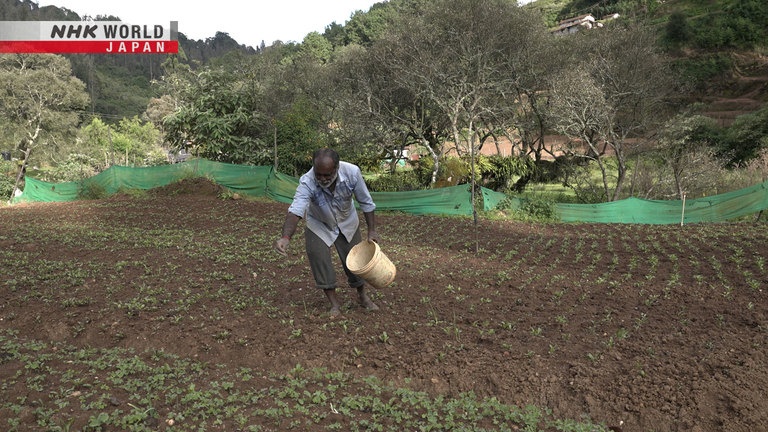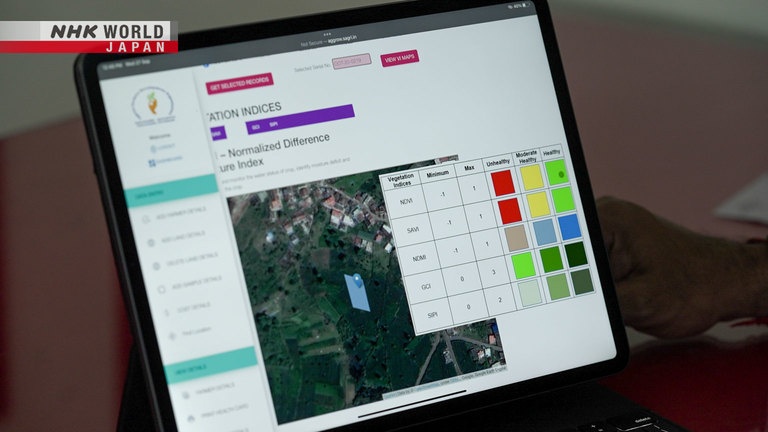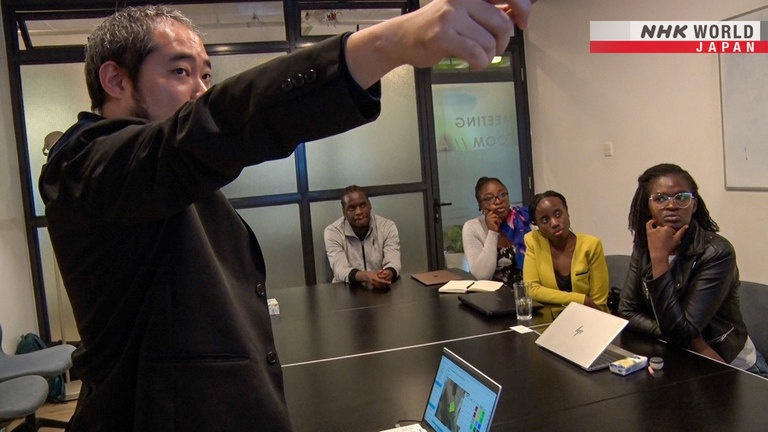Empowering Farmers through Satellites and AI: India & Kenya
A Japanese start-up is using satellite data and AI to provide soil analysis. This helps farmers in developing countries improve income by increasing yields, improving crop quality and minimizing unnecessary costs. Around 70% of Indians are farmers, but have small plots and falling incomes. Partnering with local agricultural firms, the firm now serves 4,000 farms who've seen bigger harvests, less chemical fertilizer and more income. The firm is also expanding into Thailand, Vietnam and Kenya.




Transcript
There's a revolutionary new approach to agriculture that uses satellites and AI.
It allows soil condition and crop health to be checked from anywhere on the globe.
This technology is helping farmers improve efficiency and boost their income.
Cultivation has increased.
We don't need to use so much chemicals.
Money is coming in.
The technology was developed by a Japanese startup.
CEO Tsuboi Shunsuke dreams of a better future for children in developing countries through improved farming.
Farming is often done on a very small scale.
Much of it is done by hand.
That requires more hands,
so kids have to help out.
I want to change that.
So I'm using satellite data to
improve farming techniques.
Satellites and AI can help make farming more sustainable.
Meet the farmers and the young entrepreneur engaged in this new challenge.
Udhagamandalam, a town in the southern Indian state of Tamil Nadu.
It sits around two thousand meters above sea level.
Cool all year round, it's perfect for tea cultivation.
Agriculture is a major industry in India.
Yet 70% of farmers work from small fields of less than one hectare.
Mostly farming by hand, work is inefficient, and incomes are largely stagnant.
Many rent land in a bid to expand their fields and improve efficiency.
Of the 0.6 hectares farmed by this family, two thirds is rented land.
With leases going up every year, finances are always under strain.
Those with money get land easily.
We have to work for it.
We want more for our families,
but farming requires capital.
There's another factor that has made life very hard for farmers.
The cost of fertilizer has doubled since last year, mainly due to rising oil prices.
This year was very dry and
we couldn't afford fertilizer.
I'm down 40% from last year.
The town is home to a firm that's working on improving farmer incomes.
It sells fertilizer, and distributes vegetables bought from farmers.
CEO, Palat Vijayaraghavan.
In 2022, he entered a business partnership with Tsuboi's startup towards a goal of supporting farmers.
The key is the soil analysis Tsuboi's team developed using satellite data and AI.
It enables instant visualization of a farm's soil quality.
Soil analysis is usually performed by gathering earth from each corner of the field and the center.
It's dried, then sent to an analytics firm.
Taking around a month to get results, it's a slow and costly process.
Meanwhile, the soil analysis developed by Tsuboi's firm utilizes a broad spectrum of satellite data,
including land area and wavelengths of reflected infrared light.
AI analysis can reveal the soil's carbon and nitrogen levels, as well as the current condition of the crops.
This allows farmers to instantly visualize which areas require fertilizer.
Today, Palat is visiting a field where soil analysis has highlighted a problem.
We often visit farmers' fields, we have direct interactions with the farmers to understand their different kind of challenges
so that we can optimize the programs based on their requirements.
Or based on the changing conditions.
The field is used to grow beets and garlic.
A close look at the leaves reveals that insects have been damaging the beet leaves.
Palat shows the farmer the soil analysis results, and they search for the cause of the damage.
You can see the state
of the field on this tablet.
If the crops get sick,
the field shows a pale green.
I see that.
These are the results of the analysis.
Chlorophyll levels are represented by different shades of green, the darker the healthier.
But this field is a pale green.
The soil's water content is represented in blue.
It should be a dark blue, but it, too, is pale.
The data helps Palat conclude that the insect damage is caused by a lack of moisture.
You need the right amount of water.
Not too much, not too little.
Regular provision of
the right amount of water.
Before, if crops got sick...
...my only option was to go to the fertilizer store
and ask for help.
Palat is teaching me how to treat diseases.
His proposal is helping me grow
high quality crops.
I've grown an extra 5 tons of carrots.
Today, Palat and Tsuboi's firms are collaborating to support around four thousand farms.
By joining with Sagri we are able to you know, remotely monitor all these fields at the same time.
Which brings us super efficiency.
And not only that it reduces the possibilities and - you know - the possible crop losses.
The objective data that the analysis provides has another upside for farmers.
Until now, farmers looking to loan money from the bank were often refused because the amount was too low.
The credit check was too expensive to make the loan worth it.
Now, the data provided by the analysis can be used as a credit check, and banks are more likely to provide loans.
Sagri's partnership is extremely important for us to ensure that we're able to deliver our services to farmers in the most efficient way.
So it's a humongous hope, which I'm - I'm researching in the future to work together.
Shinjuku, Tokyo.
This office belongs to the firm performing soil analysis using satellite data and AI.
Its support of farmers is carried out by a staff of 17.
They're also helping farmers in Thailand and Vietnam.
CEO Tsuboi Shunsuke started the firm while still at university.
Deeply interested in space since childhood, Tsuboi went to Yokohama National University's college of engineering science to study further.
In his third year, he launched a startup that conducted school visits to share the wonders of space with children in Japan and abroad.
He wanted the children to give free rein to their dreams.
Space is such a broad topic.
I didn't just want to lecture them.
I wanted to share ideas about
ways we could go to space.
If young kids hear it's okay to talk
about dreams it gives them hope.
It gives them the confidence to
make their own dreams come true.
A new opportunity arose for Tsuboi.
As part of his outreach program, he visited an elementary school in Rwanda.
When Tsuboi asked the children about their dreams, many told him how they wanted to be doctors or pilots.
Yet he learned that most children do not have the opportunity to go on to junior or senior high,
and these dreams are often snuffed out at a young age.
One factor preventing children from pursuing further education is that their parents often need their help to farm.
Farming is often done on a very small scale.
Much of it is done by hand.
That requires more hands,
so kids have to help out.
I realized that this was
the heart of the problem.
Tsuboi wanted to lighten the burden of farmers so their children could go to school.
He turned to satellites.
If he could apply satellite data to agriculture, he could support a huge number of people.
There are people in this situation
all over the world.
Satellite data enables visualization
of global farm conditions.
If we can add value in this way
we can help folks on the ground.
That was where I started from.
In 2018, Tsuboi launched a firm to support farmers in developing and emerging countries, leveraging satellite data and AI.
More recently, Tsuboi has succeeded in expanding his company's operations to Africa.
Although Kenya is increasingly industrialized, agriculture still accounts for 30% of its GDP.
Yet 80% of farmers have less than a hectare of land.
Many cannot make ends meet through farming, and seek work in towns and cities.
I was a farmer, I had fields.
I farmed so we could eat.
My life is still very hard.
I'm barely scraping by.
It's not easy to make ends meet
and feed kids in the city.
But it's still better here
than it was as a farmer.
Nagata Satoshi works for Tsuboi's company.
He's in Kenya to promote their soil analysis technology to local farmers.
Agricultural startups are beginning to pop up across Kenya, and Nagata sees opportunity here.
People come to Kenya from all
over Africa. There's a lot of talent.
It should be easy to find a partner.
There are plenty of agricultural players.
I think we'll find a good fit for us here.
Today, Nagata is visiting an NGO that provides guidance to small farmers on growing quality crops.
He explains the soil analysis technology in hopes the group will consider using it.
You can check the situation of every farmer,
and use your knowledge to make suggestions.
'It's too much fertilizer, please decrease.'
For example, 'This area has too much nitrogen.'
'Too much nitrogen is bad for the soil.'
- This is very interesting.
- Maybe just as a follow-up question – the analysis data, it's shared back to the farmers?
Oh yes, of course, of course.
Nagata is straightforward about the fact that the current technology isn't a perfect fit for all crops.
We can't cover coffee, or cacao.
Tea, also, we cannot do.
Also trees, like fruits.
Because from the satellite, it all looks green.
Tea and coffee are always growing.
That's why we can't check the soil
from the satellite.
- Bananas?
- Banana - difficult.
- Because of the trees.
- Yes.
- Avocado?
- Avocado, difficult yes.
So one of the things that we understand also working with small farmers is the - climate is changing and farmers also need to adapt.
But we also realize that bringing farmers along this journey is really important.
And so for me this session was helpful in terms of just hearing how the farmer can come in,
how the farmer can be supported and be enabled to - to increase productivity on their farms.
I do think most Kenyan crops
might not be a good fit.
Avocado and fruit trees don't
work well with satellite data.
But despite these limits
we could work with corn growers.
I think the key is establishing
long-term relationships here.
The Jomo Kenyatta University of Agriculture and Technology in Nairobi.
Time to get started.
Today, Nagata is talking to students in a bid to promote soil analysis technology.
For today's session, I have some case studies.
How can we solve and tackle social
challenges through satellite images?
Then let me explain about the business side.
How does it work on the ground?
Lastly, I'd like to hold an interactive session with you.
The students all listen carefully.
Questions too - yours - whatever you can.
Ask me, anything.
Thank you, thank you very much.
Do you consider other farmlands okay, or not farmlands, but lands which are degraded,
which are not - degraded, they are not being put in use at the moment.
That's a good question.
For example, we can work with unused land.
Like old mining land.
Theoretically, remote sensing is possible.
But it's not in our capability, because
we are only focusing on the farmland situation.
Most countries are focusing on creating a unified database, a data platform for smart agriculture.
However we would have challenges with data input and tracing the data.
So my question is, what measures will you put in place to counter that problem?
Thank you for that question.
One major challenge is budget problems.
They can't purchase satellite images.
Second, no manpower.
Third, farmers are not aware of the
good points of this smart farming scheme.
These three major points prevent
every government from dealing with it.
They trickled in quite slowly so
I figured it would be a small group.
By the end it was a full class
with lots of questions. I'm glad.
As part of the company's long-term plans in Kenya, Nagata is looking for local interns from among the students who took part.
What is your goal for your career?
What would you like to do?
My family is of an agricultural background, I also have an interest in agriculture and how you treat -
how it could solve problems in my field of expertise where I'm very very interested in remote sensing.
Kenya is my country and I do love my country so much. So I'm very much interested in helping the farmers.
Personally my parents are farmers so I'll be glad and very happy to see them do well in farming.
Nagata will continue making company and university visits, with the goal of getting their Kenya farming support project on track.
The company's agricultural technology has also won attention in Japan, which is battling challenges with an aging population.
Yamashita Kakuei is an official for the town of Gero.
Every year he visits all of the area's farmland to decide whether it should be listed as abandoned.
It's a massive job for the understaffed council.
I need to make a map from
countless huge pieces of paper.
I then inspect every plot of land
to make a decision about it.
Is it in use as farmland? Abandoned?
I pencil in the decision.
There are a total of 45,000 plots of farmland in Gero.
These plots are scattered among the mountains, and visiting them all is a major undertaking.
But in 2021, the Gero council enlisted the services of Tsuboi's company.
The specific plots that might have been abandoned are highlighted in gray,
and the investigator only has to make in-person visits to these locations to make a decision.
Yamashita goes to inspect one of those fields.
This is it.
I can see the grass has been cut
but there's no crops.
So it's reusable land that's
lying fallow right now.
His decision can be logged instantly through his tablet.
It's made a huge difference, as such records all used to be made by hand.
Since signing up for this service, the number of fields he has to inspect has dropped by two thirds.
He uses the extra time to find ways to address the abandoned farmland.
Some things have to be done
by people on the ground.
I'm very grateful that the service
has freed me up to focus on that.
The technology is also helping other rural farming villages go digital.
These soy beans are
the Fukuyutaka variety.
Takahashi Yukiteru runs an agricultural co-op in Mie prefecture.
He rents fields his elderly neighbors can no longer manage, and oversees a total of 32 hectares of land.
He's checking on some fields using soil analysis from satellite data and AI.
The images show the soil pH.
Soil acidity is usually measured using the pH scale, with pH7 being neutral.
Lower than 7 is acidic, and higher is alkaline.
The ideal soil pH for wheat or
soybeans is 6-6.5. Mildly acidic.
But I'm seeing five here.
And on-site, the crops we grew there
were a little small.
To economize on agrichemicals and fertilizer, Takahashi only uses alkaline lime when fields are too acidic.
A quick check with a simple measuring device reveals the soil is now a mildly acidic 6.5, perfect for growing.
But saving money is not the only reason that Takahashi does the soil analysis.
Farmers are vanishing,
with no successors.
As they age, it's vital that
we embrace digital technology.
Tsuboi says that honing the technology in Japan also helps farmers in developing nations.
Japanese and Indian agriculture
have a lot of similarities.
The crops, the small fields.
Most of Japan has small plots.
We can work abroad because
we built a healthy foundation here.
Improving the platform and
our solutions to expand abroad.
That's our current focus.
Tsuboi and his staff will continue to leverage satellite data and AI to help small-scale farmers thrive long into the future.